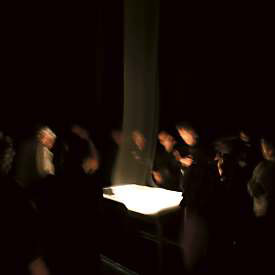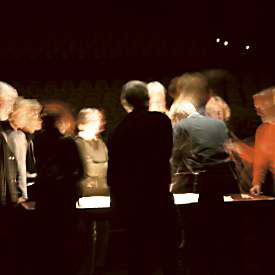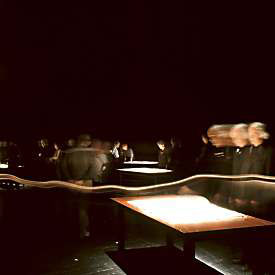11/03 Schauspielhaus Köln
1 November 2003, 3:00 p.m. to 8:00 p.m.
Kolumba as Guest with Martin Frommelt
Theatre Cologne
For the stage of the Cologne Theatre, the Museum enters the shaky territory symbolic of the world, a big abstract room which lives from its action, filled by the moving image and the spoken word. Thus the stage possesses qualities which can make the universality of a work blossom, something which cannot necessarily be achieved by hanging it in a frame on a wall.
“Creation – Five Constellations concerning Creation” is the title of a printed portfolio, painted from 1989 to 1999 by Liechtenstein artist Martin Frommelt, born in 1933. Undoubtedly, it calls for a great deal of trust in God to be able to paint a cycle bearing the title “Creation” at the end of the 20th century. On an almost daily basis new reports inform us of how man interferes in nature and how he changes it any way he likes, thereby disregarding ethical and religious traditions. Our present time has already surpassed science fiction, the anticipated future of science. Therefore, what could be more anachronistic than the artistic revision in an extraordinarily extensive portfolio of a topic which has scarcely been updated since the loss of the geocentric view of the world? However, alone its subtitle “Five Constellations concerning Creation” refers to an approach in opposition to tradition because “constellation” means “position” and “grouping”, characterising a situation in which different factors meet, defining the stroke of luck in the choice of one of many other possibilities.
In its openness, the subtitle corresponds to the chosen form of the unbound book, whose space does not fan out in a line but rather unfolds in an overlapping manner. The work comprises 214 coloured etchings on 107 sheets with a format measuring 80x120 cm. The chosen order of the five constellations at best serves as a model for continuous readability, while essential discontinuous inserts are added by observations of repetitions and permeations, as well as formal relationships and aesthetic breaks within the total cycle. Therefore, “Creation” must be leafed through in order to unfold its rich contents.
When “performing” the work, which has been spread out on five tables and whose leaves are turned by museum representatives in place of the viewer, the audience is free to move about the stage area, making discoveries in the slow progression of the sheets one after another, forming a picture as a sum of his observations. The different tables, the only props, serve as a reference to the different ways of life which are significant for the origin and adoption of the folios. Martin Frommelt condenses his impressions which are at odds with abstraction into an almost archaic and culturally unbound sign language. Creatures have been gently woven into these structures or else gradually detach themselves from them: snakes as lines meandering over the sheet, birds soaring up in ominous fashion, fish frozen in ice or time and lurking, strutting beasts of prey. It is surprising how they literally leave their concrete traces in total abstraction, filling the mental space with their warm breath.
With “Creation” Martin Frommelt evaluates the artistic principle: The pluralism of style which can be observed and the emphatically non-uniform handwriting therein become the essential, necessary characteristic of a contemporary position. “Thus art is perception of form – but through the creation of form. Only the thing which the artist can make, can he make perceivable. And if he does not succeed in giving it form, the perceivable is lost; it is not communicated. In a certain way it is not perceived” wrote the physicist and philosopher Carl Friedrich von Weizsäcker. And furthermore: “But those who always depart from the provability virtually close themselves off from certain experiences. In my opinion the conflict between myth and science is also concerned with this affective problem. […] I maintain that the development of science – especially the science where I find myself at home, namely physics – tends towards us making the tension between the provable and the non-provable discernible, recognisable, in a certain way.” (Kunst – Mythos – Wissenschaft, C.F.v.W., Zeit und Wissen, München 1995, S. 429-444.)
With its claim of universality, Martin Frommelt’s work reminds us of the comparably extensive world chronicles, above all of the world chronicle by the Nuremberg humanist Hartmann Schedel, which was first published in Latin in 1493 and translated into German in the same year. With its 1809 illuminations it marks a zenith of book art. But even more than the enormous editorial achievement, we are convinced by the artistic attitude Martin Frommelt has displayed in his mastering a process of creation lasting ten years. Furthermore, he not only tallies the balance at the end, but also sets a sign of hope that faith and knowledge are not incompatible with each other at the end of this century.
The five hours of continuous page-turning and viewing the folio corresponds with the spoken word, which like the graphic work, supposed to be projected into the room: Ten actors moving freely along among the audience will read a choice of different texts, each assigned his respective constellation.
Constellation I (Place, order and time): Passages from works by Rupert Riedl, which are a separate part of “Creation” (“Die Strategie der Genesis”, München/Zürich 1976/1984 and “Evolution und Erkenntnis. Antworten auf Fragen unserer Zeit”, München/Zürich, 1982ff.); Constellation II (Networks and strengths): Passages from the Book of Wisdom in the Old Testament (Proverbs, The Song of Salomon / Ecclesiastes); Constellation III (The elements and sensual nature): Francesco Petrarca, “The Ascent of Mont Ventoux”; Constellation IV (Messages and sense): Molly Bloom’s monologue from James Joyce’s “Ulysses””; Constellation V (Transcendence and reflection): Raimundus Lullus, “Über die einhundert Formen”, paragraph four from “Die neue Logik”.
The nearly endless structure of these texts and their changing levels of contents combine to form a multi-voiced statement of human existence which is layered upon the visual impressions of “Creation”. Together the verbal and pictorial levels facilitate an encyclopaedic examination of reality which unfolds in us an impressive panorama of seen, heard and remembered fragments.
Narrator: Michael Altmann, Susanne Barth, Heinrich Baumgarten, Ralf Harster, Anja Herden, Lukas Holzhausen, Martin Reinke, Dagmar Sachse, Markus Scheumann, Birgit Walter; Stage property: Petra Buchholz; Lighting: Magnus Rösch; Sound: Martin Töpler; Stage Direction: Joachim Idel, Martin Kammann; Directors: Konrad Oktavian Knieling, Jörg Vorhaben; Staging: Manos Tsangaris; Concept: Cologne Diözesanmuseum (Joachim M. Plotzek, Katharina Winnekes, Stefan Kraus, Ulrike Surmann, Marc Steinmann); With many thanks to the staff of the Cologne Theatre for their invitation and friendly cooperation.
(Work Book Martin Frommelt)
Kolumba as Guest with Martin Frommelt
Theatre Cologne
For the stage of the Cologne Theatre, the Museum enters the shaky territory symbolic of the world, a big abstract room which lives from its action, filled by the moving image and the spoken word. Thus the stage possesses qualities which can make the universality of a work blossom, something which cannot necessarily be achieved by hanging it in a frame on a wall.
“Creation – Five Constellations concerning Creation” is the title of a printed portfolio, painted from 1989 to 1999 by Liechtenstein artist Martin Frommelt, born in 1933. Undoubtedly, it calls for a great deal of trust in God to be able to paint a cycle bearing the title “Creation” at the end of the 20th century. On an almost daily basis new reports inform us of how man interferes in nature and how he changes it any way he likes, thereby disregarding ethical and religious traditions. Our present time has already surpassed science fiction, the anticipated future of science. Therefore, what could be more anachronistic than the artistic revision in an extraordinarily extensive portfolio of a topic which has scarcely been updated since the loss of the geocentric view of the world? However, alone its subtitle “Five Constellations concerning Creation” refers to an approach in opposition to tradition because “constellation” means “position” and “grouping”, characterising a situation in which different factors meet, defining the stroke of luck in the choice of one of many other possibilities.
In its openness, the subtitle corresponds to the chosen form of the unbound book, whose space does not fan out in a line but rather unfolds in an overlapping manner. The work comprises 214 coloured etchings on 107 sheets with a format measuring 80x120 cm. The chosen order of the five constellations at best serves as a model for continuous readability, while essential discontinuous inserts are added by observations of repetitions and permeations, as well as formal relationships and aesthetic breaks within the total cycle. Therefore, “Creation” must be leafed through in order to unfold its rich contents.
When “performing” the work, which has been spread out on five tables and whose leaves are turned by museum representatives in place of the viewer, the audience is free to move about the stage area, making discoveries in the slow progression of the sheets one after another, forming a picture as a sum of his observations. The different tables, the only props, serve as a reference to the different ways of life which are significant for the origin and adoption of the folios. Martin Frommelt condenses his impressions which are at odds with abstraction into an almost archaic and culturally unbound sign language. Creatures have been gently woven into these structures or else gradually detach themselves from them: snakes as lines meandering over the sheet, birds soaring up in ominous fashion, fish frozen in ice or time and lurking, strutting beasts of prey. It is surprising how they literally leave their concrete traces in total abstraction, filling the mental space with their warm breath.
With “Creation” Martin Frommelt evaluates the artistic principle: The pluralism of style which can be observed and the emphatically non-uniform handwriting therein become the essential, necessary characteristic of a contemporary position. “Thus art is perception of form – but through the creation of form. Only the thing which the artist can make, can he make perceivable. And if he does not succeed in giving it form, the perceivable is lost; it is not communicated. In a certain way it is not perceived” wrote the physicist and philosopher Carl Friedrich von Weizsäcker. And furthermore: “But those who always depart from the provability virtually close themselves off from certain experiences. In my opinion the conflict between myth and science is also concerned with this affective problem. […] I maintain that the development of science – especially the science where I find myself at home, namely physics – tends towards us making the tension between the provable and the non-provable discernible, recognisable, in a certain way.” (Kunst – Mythos – Wissenschaft, C.F.v.W., Zeit und Wissen, München 1995, S. 429-444.)
With its claim of universality, Martin Frommelt’s work reminds us of the comparably extensive world chronicles, above all of the world chronicle by the Nuremberg humanist Hartmann Schedel, which was first published in Latin in 1493 and translated into German in the same year. With its 1809 illuminations it marks a zenith of book art. But even more than the enormous editorial achievement, we are convinced by the artistic attitude Martin Frommelt has displayed in his mastering a process of creation lasting ten years. Furthermore, he not only tallies the balance at the end, but also sets a sign of hope that faith and knowledge are not incompatible with each other at the end of this century.
The five hours of continuous page-turning and viewing the folio corresponds with the spoken word, which like the graphic work, supposed to be projected into the room: Ten actors moving freely along among the audience will read a choice of different texts, each assigned his respective constellation.
Constellation I (Place, order and time): Passages from works by Rupert Riedl, which are a separate part of “Creation” (“Die Strategie der Genesis”, München/Zürich 1976/1984 and “Evolution und Erkenntnis. Antworten auf Fragen unserer Zeit”, München/Zürich, 1982ff.); Constellation II (Networks and strengths): Passages from the Book of Wisdom in the Old Testament (Proverbs, The Song of Salomon / Ecclesiastes); Constellation III (The elements and sensual nature): Francesco Petrarca, “The Ascent of Mont Ventoux”; Constellation IV (Messages and sense): Molly Bloom’s monologue from James Joyce’s “Ulysses””; Constellation V (Transcendence and reflection): Raimundus Lullus, “Über die einhundert Formen”, paragraph four from “Die neue Logik”.
The nearly endless structure of these texts and their changing levels of contents combine to form a multi-voiced statement of human existence which is layered upon the visual impressions of “Creation”. Together the verbal and pictorial levels facilitate an encyclopaedic examination of reality which unfolds in us an impressive panorama of seen, heard and remembered fragments.
Narrator: Michael Altmann, Susanne Barth, Heinrich Baumgarten, Ralf Harster, Anja Herden, Lukas Holzhausen, Martin Reinke, Dagmar Sachse, Markus Scheumann, Birgit Walter; Stage property: Petra Buchholz; Lighting: Magnus Rösch; Sound: Martin Töpler; Stage Direction: Joachim Idel, Martin Kammann; Directors: Konrad Oktavian Knieling, Jörg Vorhaben; Staging: Manos Tsangaris; Concept: Cologne Diözesanmuseum (Joachim M. Plotzek, Katharina Winnekes, Stefan Kraus, Ulrike Surmann, Marc Steinmann); With many thanks to the staff of the Cologne Theatre for their invitation and friendly cooperation.
(Work Book Martin Frommelt)


